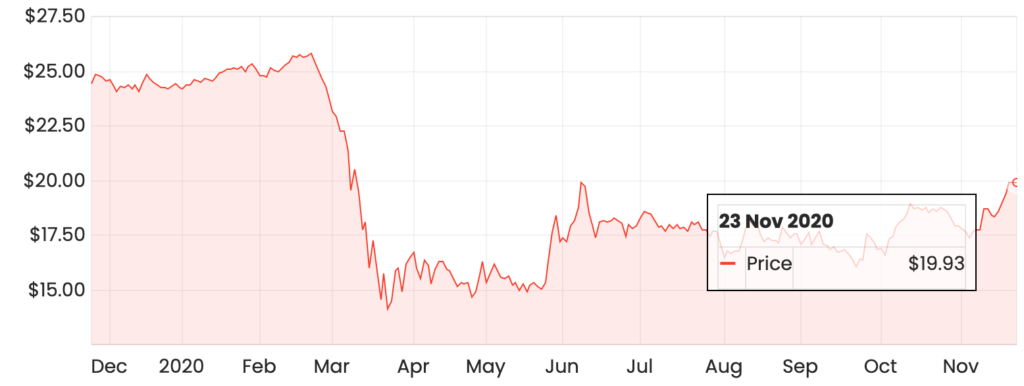The Westpac Banking Corp (ASX: WBC) share price is up about 30% in the past six months. However, Westpac shares are still down around 18% over the last 12 months. Could it be time to buy?
WBC share price chart

Source: Rask Media WBC 12-month share price chart
Westpac is Australia’s oldest bank, first established in 1817 as the Bank of New South Wales. Today, Westpac is a member of the ‘Big Four’ and has a 22% market share of the Australian mortgage market.
FY20 recap
On 2 November, Westpac announced a disappointing FY20 result. The bank reported cash earnings of $2,608 million, down 62%, and statutory earnings of $2,290 million, down 66%.
Westpac calculates cash earnings by adjusting statutory earnings for three factors: material items that do not reflect ongoing performance, items that may not be considered when determining dividends, and accounting treatment of individual items that do not affect reported results.
Commenting on the results, Westpac CEO Peter King said, “lending stalled over the year. While demand was lower, we did not keep pace with the market – particularly in our core mortgage portfolio. Net interest margins were also down due principally to low interest rates and a highly competitive market.”
Westpac’s earnings were also impacted by costs associated with AUSTRAC penalties.
Why is the Westpac share price rallying?
While Westpac’s results were disappointing, here are a few key reasons why the Westpac share price could be rallying.
On 25 September, the government announced a number of changes to Australia’s consumer credit framework detailed in the National Consumer Credit Protection Act 2009. The changes are designed to cut some of the red tape associated with individuals and small businesses accessing credit. Subject to the legislation being passed, changes will come into effect on 1 March 2021. Investors may have viewed these changes as benefitting Westpac through increased demand for credit.
Detailed in Westpac’s FY20 results, the bank saw the number of mortgage repayments deferred by customers fall 66%. Earlier in 2020, Westpac began allowing mortgage holders who had lost their job or lost income stemming from the COVID-19 pandemic to defer repayments. The fact that two in three of those deferring repayments had re-commenced may be indicative of rising economic activity.
According to leading property data provider CoreLogic, Australian home values experienced a 0.4% rise in October. CoreLogic advised home values increased in all capital cities, with the exception of Melbourne. Australians’ confidence in bidding up house prices could be somewhat attributed to falling COVID-19 case numbers.
Is it a good time to buy Westpac shares?
Many people would be looking to pick up Westpac shares for dividends. Westpac did not pay an interim dividend this year, and the final dividend was down 61% on the prior year to $0.31 per share.
That said, the final dividend was restricted by APRA’s request in July this year which capped banks’ dividend payout ratios at 50%.
Looking forward, I am unsure if Westpac will be able to meaningfully grow earnings and therefore dividends in the current low economic growth environment.
In my view, Challenger Ltd (ASX: CGF) shares may present a better dividend investment opportunity. Click here to read my recent analysis of Challenger.





